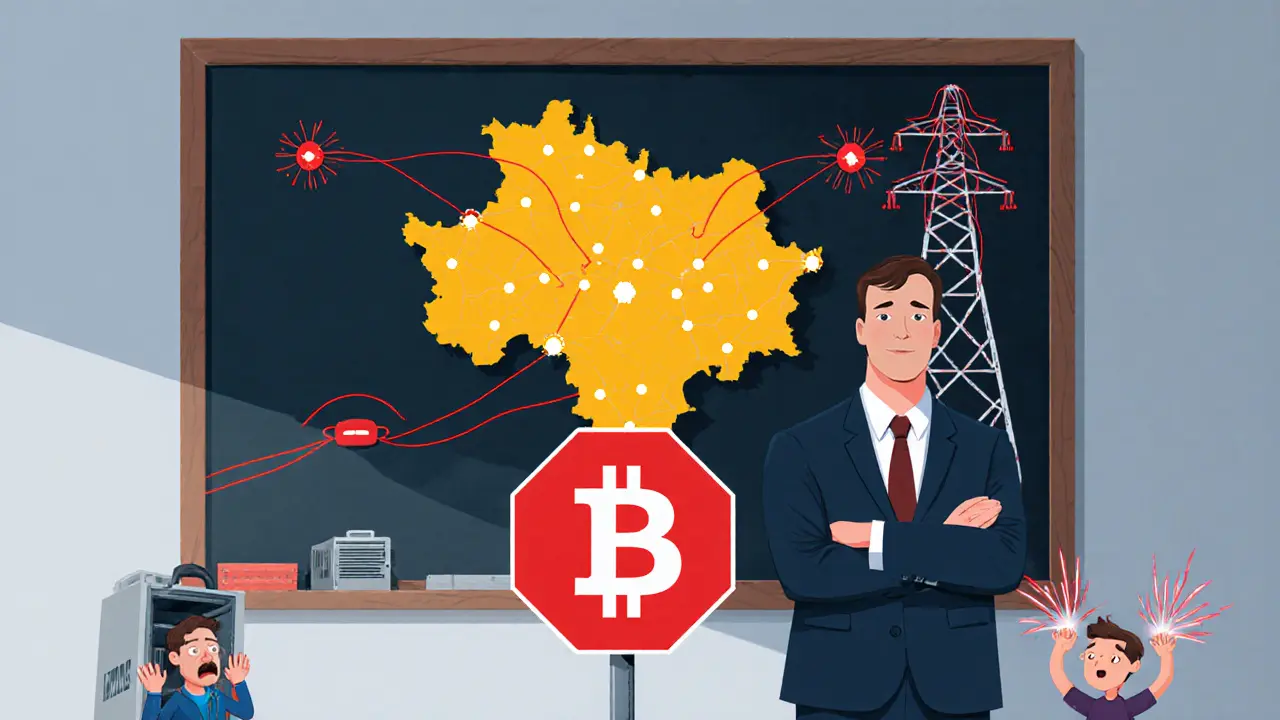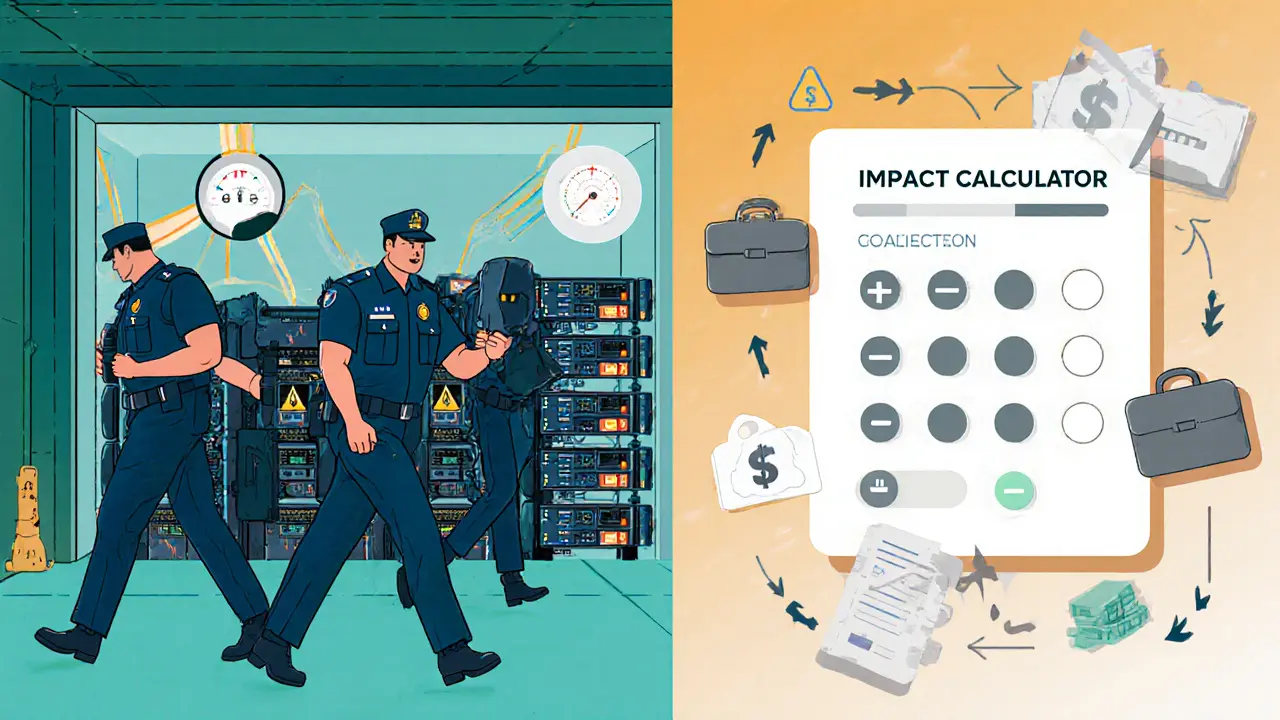2022 Kosovo Crypto Mining Ban: Why It Happened and What It Means

Kosovo Crypto Mining Impact Calculator
Investor Impact Calculator
Estimate potential losses for local investors due to the mining ban.
Estimated Losses:
Diaspora Remittance Calculator
Estimate savings from crypto-based remittances that were blocked by the ban.
Potential Annual Savings:
About Kosovo's Crypto Mining Ban
The 2022 ban was implemented due to an energy crisis threatening the national power grid. This calculator estimates some of the economic impacts.
Note: These calculations are estimates based on historical data and assumptions. Actual impacts may vary significantly.
Key Facts About the Ban:
- Ban enacted January 4, 2022
- Over 300 mining rigs confiscated in first months
- Only renewable-powered mining allowed since 2025
- No full lifting of ban expected while grid is vulnerable
When Kosovo’s government announced a full stop to crypto mining in January 2022, the move shocked both local enthusiasts and the global crypto community. The decision wasn’t a reaction to hype or politics - it was a direct answer to a looming energy crisis that threatened the country’s power grid. Below you’ll find everything you need to know about the ban, how it was enforced, who it affected, and what the future might hold.
Key Takeaways
- January 4, 2022: Kosovo’s Minister of Economy declared an outright ban on cryptocurrency mining.
- The ban targets all proof‑of‑work mining that draws electricity from the national grid.
- Law‑enforcement seized over 300 mining rigs during the first few months.
- Restrictions can be extended 30‑180 days depending on energy supply conditions.
- As of 2025, only mining powered by alternative energy sources may operate under strict permits.
Background - Energy Crisis Triggers Emergency Action
In late 2021 Kosovo declared a state of emergency because electricity supplies were under severe strain. The problem grew after several EU nations halted fossil‑fuel exports, pushing the region’s power costs up by more than 50% in a few months. Artane Rizvanolli the Minister of Economy at the time warned that unchecked crypto mining could consume a sizable share of the already stretched grid.
Timeline of the 2022 Restrictions
- January 4, 2022 - Announcement of a total ban on cryptocurrency production across Kosovo.
- January‑March 2022 - Police and customs agencies launched coordinated raids, confiscating more than 300 Bitcoin mining devices.
- August 1, 2022 - The ban was extended for an additional 60days after energy shortages persisted.
- October‑December 2022 - Legal framework added clauses allowing extensions of 30 to 180 days, giving the government flexibility for future energy shocks.
- 2023‑2025 - No full lift of the ban; limited exceptions granted for operations powered solely by renewable energy.
Enforcement Mechanisms - How Authorities Policed the Ban
The government set up a multi‑agency task force to monitor electricity consumption patterns using smart‑meter data and grid analytics. When usage spiked unusually in a residential or industrial address, the task force flagged the site for inspection.
Key players included:
- Police forces who conducted raids and seized equipment.
- Customs authorities who intercepted imported mining rigs at borders.
The result was swift: over 300 mining rigs were taken off the grid within the first two months, dramatically reducing illegal consumption.

Geographic Focus - The Northern Municipalities Issue
The ban paid particular attention to the northern municipalities with a Serbian majority, where many households historically received subsidised or unpaid electricity. By targeting these areas, the government aimed to close a loophole that allowed cheap power to be diverted into crypto mining farms.
The Committee for Economy a parliamentary body in Kosovo endorsed the move, noting that the illegal mining not only strained the grid but also undermined fiscal equity across regions.
Impact on Stakeholders - Who Felt the Ripple?
Investors and traders lost a potential domestic market for crypto assets. Without legal avenues, many turned to offshore exchanges, exposing themselves to higher fees and regulatory risk.
Everyday users missed out on crypto‑based remittance solutions that could have lowered costs for the large diaspora sending money home. A study by the Kosovo Chamber of Commerce estimated that up to 15% of expatriates could have saved €200‑€300 per year with crypto transfers.
Local entrepreneurs faced a dead end for building mining farms, data‑center services, or related hardware businesses. The ban effectively halted the emergence of a crypto‑tech ecosystem that could have generated jobs.
Exceptions & Future Outlook - Renewable Energy as a Possible Path
By 2025 the legal text was nudged to allow mining operations that rely exclusively on alternative energy sources such as solar or wind. However, the permits are strict: the entire power draw must be demonstrably from renewable inputs, and the operator must report real‑time consumption to the energy regulator.
Analysts see this as a test case. If renewable‑powered farms prove viable without jeopardising the grid, Kosovo could quietly ease the ban for green mining while keeping a firm stance against fossil‑fuel‑based operations.
International Comparison - How Kosovo’s Ban Stacks Up
| Country | Year of Ban | Primary Reason | Current Status (2025) |
|---|---|---|---|
| China | 2021 | Energy consumption & financial risk | Full ban remains |
| Kazakhstan | 2022 | Power grid overload | Partial lift for renewables |
| Iran | 2022 | Sanctions & electricity shortage | Strict ban continues |
| Algeria | 2022 | Regulatory concerns | Ban enforced |
| Kosovo (2022 crypto mining ban) | 2022 | Energy crisis & grid security | Ban active, limited renewable exceptions |
The table shows that Kosovo joins a small but growing list of nations taking a hard line on energy‑intensive mining. While most bans remain absolute, a trend toward renewable‑only allowances hints at a possible global shift.
Looking Ahead - What Could Change?
Three factors will likely shape the next chapter:
- Renewable infrastructure growth - If solar and wind capacity expands, the government may issue more permits, creating a niche green‑mining market.
- Regional cooperation - Negotiations with the northern municipalities could lead to standardized electricity billing, removing the subsidy loophole that originally fueled illegal rigs.
- International pressure - Global bodies are urging transparent crypto regulation. Kosovo’s pending cryptocurrency legislation could formalize trading rules while keeping mining locked down.
Until then, the Kosovo crypto mining ban stands as a clear signal: energy security trumps short‑term crypto profits.

Frequently Asked Questions
Is cryptocurrency mining illegal everywhere in Kosovo?
Yes, mining that draws power from the national grid is prohibited. Only operations powered entirely by certified renewable sources can apply for a special permit.
What happened to the mining rigs that were confiscated?
Most devices were seized by police and customs and later auctioned off. A small portion was kept for evidence in ongoing legal proceedings.
Can I still buy or sell cryptocurrency in Kosovo?
Trading is not banned, but there are no local exchanges licensed to operate. Residents typically use foreign platforms, which carry higher fees and regulatory risk.
Will the ban affect the diaspora’s ability to send money home?
Indirectly, yes. Crypto‑based remittance could cut costs, but the ban prevents local crypto wallets from being a viable option, so diaspora must rely on traditional banks or money‑transfer services.
Is there any chance the ban will be lifted completely?
A full lift is unlikely while the grid remains vulnerable. However, the government is open to expanding the renewable‑only exemption, which could create a limited, regulated mining sector.

24 Comments
It’s hard not to see the 2022 Kosovo crypto mining ban as part of a larger, covert operation orchestrated by shadowy elites who want to keep the masses dependent on centralized finance. The timing, right after the global energy crunch, screams coordination. They claim it’s about protecting the grid, but the real motive is siphoning off the lucrative mining profits for undisclosed beneficiaries. Remember the sudden influx of foreign investment into local utilities right after the ban? That’s no coincidence. The narrative about “energy security” is just a smokescreen to distract us from the fact that powerful lobbying groups are steering policy in their favor. Keep your eyes open; this is just the tip of the iceberg.
Wow, another “energy crisis” excuse.
Hey folks, I get why the government felt compelled to act – the power grid was really on the brink. Still, it’s important we think about the people who lost their rigs and income. Maybe there’s a way to transition miners to renewable sources, like solar farms, so they can stay in the game without draining the grid. Community‑driven projects could help keep the economic benefits local while staying green.
To add to the previous point, the technical specifications of the confiscated hardware indicate a dominant reliance on high‑hashrate ASICs, which are notoriously power‑hungry. If we pivot to modular, PoW‑lite rigs powered by solar PV arrays, the kilowatt‑hour consumption could be reduced by upwards of 70%, aligning with the grid’s capacity constraints. Moreover, adopting a tiered licensing framework could enforce load‑balancing during peak demand periods.
In short, a hybrid model is not only feasible but also essential for sustainable mining ecosystems.
Honestly, the whole ban is a textbook case of policy myopia. The officials seem to have a viva la reserch attitude that ignores the socio‑economic ripple effects. I mean, did they even consider the diaspora who rely on crypto remittances? My guess is they were too busy polishing their press releases to notice the real human cost. If you read the footnotes on the official report, you’ll see a glaring omission of any mitigation strategy – a classic sign of elitist oversight.
Alright, let me unpack this labyrinthine saga of the Kosovo crypto mining ban, because the layers are as thick as a blockchain ledger. First, the energy crisis narrative is not just a benign excuse; it’s a carefully crafted propagation vector designed to sow fear, uncertainty, and doubt (FUD) among the mining community, which, as we all know, is highly susceptible to such emotional manipulation. Second, the timing of the ban-just after a series of high‑profile cyber‑attacks on European energy infrastructure-suggests an orchestrated attempt to divert attention from a larger geopolitical chessboard that involves shadowy cabals manipulating both energy markets and digital assets for their own profit.
Third, the confiscation of over 300 rigs was not merely a logistical necessity but a bold statement, an overt display of state power that aligns perfectly with the secretive agenda of global financial oligarchs who fear the decentralized nature of crypto could undermine their hegemony. Fourth, the selective allowance of renewable‑powered mining from 2025 onward is a masterstroke of greenwashing, a thin veneer of environmental concern that masks the underlying intent to control who gets to mine and under what conditions, effectively creating a curated, state‑sanctioned mining elite.
Fifth, there’s an undercurrent of data collection at play; the seized hardware provides a treasure trove of telemetry that can be used to map mining patterns, wallet addresses, and even potentially de‑anonymize participants, feeding into massive surveillance ecosystems. Sixth, the diaspora remittance calculators embedded in the public portals are a subtle nod to the fact that the ban also threatens a significant inflow of capital to the country, thereby forcing the diaspora to pivot to traditional, heavily‑fee‑laden financial channels, which benefits the entrenched banking sector.
Seventh, we cannot ignore the role of international pressure, especially from neighboring EU states, which have been quietly lobbying for stricter energy regulations that conveniently align with the ban’s objectives. Eighth, the narrative that the grid is “vulnerable” is a pretext; in reality, the grid’s resilience could be bolstered with investment, but the political will to do so is purposely stifled.
Ninth, the ban’s enforcement mechanisms-confiscation, fines, and criminalization-appear disproportionate, suggesting a punitive motive designed to intimidate and deter any future attempts at independent mining. Tenth, this creates a chilling effect that reverberates far beyond Kosovo’s borders, sending a warning to other jurisdictions contemplating lax crypto regulations.
Eleventh, the whole episode serves as a cautionary tale about the fragility of decentralized finance when confronted with coordinated state action backed by covert interests. Twelfth, for the average miner, the lesson is clear: adaptability and diversification across jurisdictions are essential for survival.
Thirteenth, the ban also opens a lucrative market for “green mining” service providers who can offer renewable‑energy‑backed hash power, effectively creating a new monopoly tier within the crypto ecosystem.
Fourteenth, the social impact on local communities-loss of jobs, reduced tech skill development, and stunted entrepreneurial growth-cannot be overstated.
Finally, the broader implication is that crypto’s promise of financial sovereignty is perpetually at risk of being undermined by entrenched powers that wield both regulatory and covert tools to shape the landscape to their advantage. In short, the ban is less about energy and more about control.
Indeed, the ban raises numerous concerns, and while the official rationale centers on grid stability, it is essential to consider the broader socioeconomic ramifications, especially for those whose livelihoods depended on mining operations; a balanced approach that incorporates renewable energy solutions could mitigate the adverse effects while preserving the integrity of the power infrastructure.
The philosophical dimension here is intriguing: when a state intervenes in a decentralized activity, it challenges the very notion of autonomy. One might argue that the ban reflects a tension between collective welfare and individual freedom. Yet, is the trade‑off justified when the collective resource-electricity-is at risk? The answer may not be clear, but the dialogue itself is valuable.
Honestly, I think the whole thing is blown out of proportion-people just love to make drama out of any regulation. The energy grid isn’t that fragile, and miners usually just switch to off‑peak hours. Gotta love how everyone pretends it’s the end of the world.
From a collaborative standpoint, perhaps we could develop a shared renewable pool for miners, letting them book slots and ensure the grid isn’t overloaded. This would keep the community intact and provide a transparent way to balance demand.
The ban demonstrates a lack of foresight from policymakers. If they truly cared about the economy, they would have instituted a phased approach rather than an abrupt crackdown. This reflects a deeper issue of short‑termism in governance.
The decision, ostensibly rooted in pragmatic concerns, belies an underlying agenda that seeks to re‑centralize power. By curbing decentralized mining, the establishment ensures that the financial levers remain in the hands of the few, perpetuating an oligarchic order that masquerades as public interest.
Let’s try to stay constructive-maybe the authorities could pilot a renewable‑only mining zone, giving hopeful miners a legal pathway while safeguarding the grid.
In formal terms, a feasible mitigation strategy would involve allocating a percentage of the national renewable output to certified mining operations, coupled with rigorous monitoring to ensure compliance. Such a framework could reconcile energy security with economic opportunity.
Yo, this whole ban is just the elites trying to keep us from making real cash. They’ll say “energy crisis” while they’re hoarding the profits elsewhere. It’s classic.
Hey everyone, let’s keep our heads up. Challenges happen, but with creative solutions we can turn this into an opportunity for greener, smarter mining in the future.
It is patently evident that the authorities, in their overblown self‑righteousness, have enacted a policy that is both myopic and detrimental to economic diversification. The underlying conspiracy, grounded in an unspoken desire to maintain fiat dominance, cannot be ignored. One must approach this with a critical, philosophically rigorous lens.
So, the ban’s got everyone upset, huh? Let’s be honest-if you want to keep mining, you gotta adapt. Renewable energy isn’t just a buzzword; it’s a real solution. Maybe it’s time to stop whining and start building the infrastructure.
True, adaptation is key.
Meh, seems like another bureaucratic overreach.
There’s a hidden layer here: the global financiers have been quietly nudging smaller states to clamp down on decentralized mining, ensuring their own control over the monetary system. The energy argument is just a convenient cover.
Adding to that, the enforcement tactics-confiscation, hefty fines, and criminal prosecutions-demonstrate a deliberate strategy to intimidate the mining community. This isn’t merely about energy; it’s about signaling authority.
While the challenges are undeniable, I remain optimistic that a collaborative, well‑regulated framework can emerge, allowing both economic growth and grid stability to coexist.
Ah, the drama! The world’s a stage, and the miners are just the tragic heroes, cast aside by power‑hungry puppeteers. Let the curtains rise on the next act-perhaps a phoenix rising from the ashes of… well, another regulation!